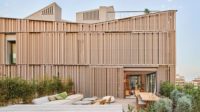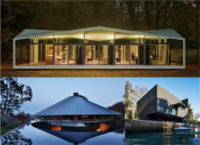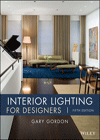Fabrikstrasse 15













2. office floors
3. atrium
4. auditorium
5. IT learning classrooms
6. skylight
7. campus green

2. office floors
3. atrium
4. auditorium
5. IT learning classrooms
6. skylight
7. campus green














Architects & Firms
Basel, Switzerland
Breaking the bounds of of Vittorio Magnago Lampugnani's master plan, Fabrikstrasse 15 by Frank Gehry stands in a surprising juxtaposition to the serene array of rectilinear buildings that dominate the Novartis campus. It is located at the geographic heart of the campus, in full view of the company's renovated 1939 Forum 1 International Headquarters building, and across the street from a refined stretch of porticoed offices and labs by Adolf Krischanitz, Rafael Moneo, Lampugnani, and Yoshio Taniguchi. The highly visible, independent site gave the architect freedom to exploit his expansive, free-spirited style.
Relieved from many of the constraints binding the other architects, Gehry and his team created a voluminous 209,896-square-foot building that manifests the Novartis commitment to an open and environmentally responsible workplace in its crystalline transparency and intricate sustainable strategies.
Anchored to a load-bearing reinforced-concrete skeleton that sits on a rigid 56-foot-deep basement box, the building's structural steel shell supports an active triple-glazed envelope that is tied to its natural ventilation and lighting systems through a centralized building facility-management system. Like a finely tuned machine, the building performs unobtrusively to provide comfortable surroundings for its occupants. Sliding glass doors on the ground floor and operable windows discharge excess solar yields and facilitate the flow of outside air, aided by a mechanical fresh-air system around the perimeters of the upper levels.
Home to the human resources (HR) department, as well as to a top-floor campus reading room, a 600-seat multiuse auditorium and IT learning center (both below grade), and a ground-floor restaurant and caf' that spill out onto the campus green, Fabrikstrasse 15 is a hub of activity. The warm, wood-lined interiors feature whimsical LED-backed-veneer media-columns and modular Gehry-designed furnishings and workstations.
In accordance with Novartis chairman Daniel Vasella's versatile “multi-space” office concept, the architects arranged the HR floors on the five upper levels with flexible, open-plan work spaces and glass-enclosed “private rooms,” bisecting them with a central atrium and serpentine stainless steel stair to bring light down through the core of the volume. A series of skylights strategically inserted into the floor and grounds around the building carry daylight to the caf', the lower-level learning center, and the auditorium stage.
According to Gehry Partners project architect Kamran Ardalan, daylight is harvested and managed in several ways: The low-E glazing is articulated with ceramic frits on the facade to reduce direct solar gain; an orchestrated series of low-E-coated, saillike interior shades operate on sensors to minimize glare and additional heat; and sound-absorbing lamellas under the roof diffuse sunlight and further compensate for the thermal load by serving as cooling radiators filled with slightly chilled water. In addition, photovoltaic cells integrated into the glass roof panels not only generate enough power for the building's electric lighting, they supply an additional layer of solar shading.
“The amount of daylight inside the building is consistently monitored,” says Ardalan. Electric lighting is used only when there isn't enough daylight, he adds — and to illuminate the building at night.
Looking frosted and icy-white on a bright afternoon, the building assumes a brilliant clarity as the sun sets, revealing its inner workings like a child's “visible engine” kit. This effect stems from a perceptive, energy-efficient electric lighting scheme by the New York'based L'Observatoire that balances program and architecture.
It was a challenge, says principal Herv' Descottes: “It's such a transparent building that you could lose its sculptural aspects.” To achieve a soft, lanternlike glow, Descottes and his team layered the structure with light from within.
Initially, they created a layer by washing the mullions of the facade with metal-halide uplights installed inside the perimeter of the first level. Then they added a second layer of ambient and task lighting on the office floors, using compact fluorescent lamps. Here the lighting team kept the general light levels lower than usual to emphasize the glow of the fixtures at each desk, a tactic used to establish an intimate ambience for employees.
Next they installed linear fluorescent fixtures to wash the wood walls on all the levels, and inserted cool T5s above awninglike glass ceiling panels in the auditorium that create a seamless transition with the sunlight penetrating the skylight.
Last, they lined the atrium with adjustable metal-halide fixtures from the ground floor up to the roof, directing them up and down, and reflecting light off the white lamellas. This move, perhaps the most important, brightens the center of the building and underscores its voluptuous form.
During a recent visit on a warm and sunny summer morning, the offices were bursting with light — without a hint of glare — and wonderfully temperate minus the chill of air conditioning. A holistic tour de force, Fabrikstrasse 15 is illuminating in its transparency and ability to harness the aura and power of light — both generated and from the sun. Such a building defines the spirit of Novartis as an enlightened workplace.
Owner: Novartis Pharma AG
Completion Date: June 2009
Gross square footage: 19´500 m2
Total construction cost: Confidential
Architect:
Gehry Partners, LLP
12541 Beatrice Street
Los Angeles, CA 90066
Tel: 310-482-3000
Fax 310-482-3006
PeopleArchitect: Personnel in architect's firm who should receive special credit: Principal Project Team: Schematic Design Project Team: Architect of record Project Team: Interior designer Engineer(s) Consultant(s) CAD system, project management, or other software used |
ProductsStructural system Metal/glass curtain wall: Josef Gartner GmbH: Gundelfingen, Germany. GlazingGlass:Curtain Wall: Glass by BGT Bischoff Glastechnik: Bretten, Germany, Curtian wall engineering and installed by Josef Gartner GmbH: Gundelfingen, Germany. Skylights: Entrances: Josef Gartner GmbH: Gundelfingen, Germany Locksets: Frank O. Gehry Design, Valli e Valli, Italy Acoustical ceilings: Two prodcuts used: Suspension grid: Plastic laminate: Office furniture: Gehry Partners LLP, with Vitra International Manufacturer: Erco, Neuco, Regent, Schmitz, Reggianni, Philips, Regiolux, Zumtobel Pendant Lighting: Restaurant – Mama Cloud designed by Frank O. Gehry; Manufactured by Belux. Elevators/Escalators: Schindler AG, Switzerland Energy Other unique products that contribute to sustainability: Façade Components:
Air-conditioning Technology:
Project awaiting Minergie Certification. Additional building components or special equipment that made a significant contribution to this project: |





